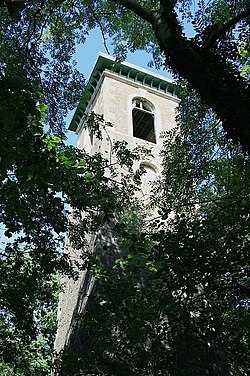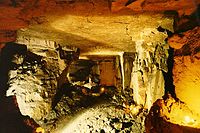Brown's Folly
| Brown's Folly | |
|
Somerset | |
|---|---|

| |
| Type: | Folly |
| Location | |
| Grid reference: | ST79486606 |
| Location: | 51°23’36"N, 2°17’47"W |
| History | |
| Folly | |
| Information | |
Brown's Folly is a folly tower on the Farleigh Rise near the village of Bathford in Somerset. The Folly was designated a Grade II listed building in 1988.[1] It gave its name to a 100 acre Site of Special Scientific Interest, notified in 1974.[2]
The tower was built in 1845 by Colonel Wade Browne, the squire of Monkton Farleigh Manor, to provide employment during an agricultural recession.[2] It replaced a semaphore tower which had previously stood on the site.[3]
The tower has a square plan and tapers as it rises. The upper stage has round arched openings and balustraded handrails, although the balustrading is missing on the north and west sides.[1]
In 1907 the tower was renovated by the owner of the estate, Charles Hobhouse, who had his shooting parties meet at the tower.[4][5] Demolition was suggested in 1938 but did not take place.[6] The Folly is structurally sound, but is not currently open to the public. Since 1998 it has been maintained by the Folly Fellowship who replaced the roof.[4]
A depiction of the Folly appears on the unofficial coat of arms of Bathford Parish Council.[7]
Nature reserve

Wade Browne's Folly (ST793662) is a folly tower sitting within a 98.5 acre biological and geological Site of Special Scientific Interest near the village of Bathford in the north of Somerset. The site itself is known as the Farleigh (sometimes Farly) Down Stone Quarry, and is managed as a nature reserve by the Avon Wildlife Trust (AWT).
- Location map: 51°23’40"N, 2°17’56"W
The site is situated on steep west-facing slopes which overlook the River Avon. The calcareous soils have developed on Lower Lias clays, fuller's earth and oolitic limestone strata of Jurassic age.[8] The local geology is of major importance in the context of the British Bathonian stratigraphy.[8]
The site includes the remains of quarries used for the extraction of Bath Stone. These provide a rich variety of wildlife habitats. Downland flora has covered the spoilheaps where wild thyme, harebell and nine species of orchid (including the rare Fly Orchid) are found.[9]:252 Yellow Bird's-nest occurs here.[9]:108 The damp cliff faces support a variety of ferns, fungi and spiders. Pockets of ancient woodland on the lower slopes are home to woodpeckers, and unusual plants such as Bath asparagus.
Old quarries
The old underground quarries are used for roosting by the Greater Horseshoe Bat,[10] and five other bat species are present at the site.[8] The main bat roost area is clearly marked on the survey created by the SMCC, and everyone is asked to avoid the area. Boris, the oldest Greater Horseshoe Bat ever recorded in Britain, was discovered at Browne's Folly in January 2000.[11] The underground workings themselves are of great speleological and historical interest. They are extremely well decorated and contain many delicate stalactites and examples of gull formation (caves features formed by land slippage). The quarry workings provided stone for the façade of Buckingham Palace.
Access
In 2000, access was unilaterally withdrawn by the Avon Wildlife Trust pending the results of a mine inspector's report on the safety of the mines. This report was required because of the Health and Safety at Work Act which affects employees and volunteers of Avon Wildlife Trust who might have to enter the mine to count the bats. These legal requirements do not affect leisure access by cavers. Prior to 2000, access to the mine was controlled by the Council of Southern Caving Clubs and cavers coexisted with a thriving bat population with voluntary restrictions on the access during the bat roosting season. There is no evidence of caving activity adversely affecting the bat population. Other locations such as Box Freestone quarry have seen rising bat populations despite becoming very popular.
Conservation
Although the site is owned and managed by the AWT, the old quarry is maintained by cavers and mine explorers who remove graffiti and litter as well as repair damage and naturally occurring falls to keep passages open and relatively safe. Access to both the caves and tower is dangerous and people should not descend the one or ascend the other without expert guidance. Visitors are also reminded that anyone who destroys or damages a bat roost is breaking the law and susceptible to heavy fines or imprisonment.
Outside links
- The inside of the tower - YouTube
References
- ↑ 1.0 1.1 National Heritage List 1021829: Brown's Folly
- ↑ 2.0 2.1 "Brown's Folly", Avon Wildlife Trust, http://www.avonwildlifetrust.org.uk/reserves/brownes-folly, retrieved 18 August 2011
- ↑ "£75,000 awarded to Browne’s Folly site". Foll-e 34. 2011. http://www.follies.org.uk/pdf/Foll-e%2034%20-%20January%202011.pdf.
- ↑ 4.0 4.1 "Brown's Folly - The Tower". Derelict Places. http://www.derelictplaces.co.uk/main/misc-sites/21149-browns-folly-tower-jan-2012-a.html#.V95c8PArKUk. Retrieved 18 September 2016.
- ↑ "Browne's Folly Appeal". Follies 9 (3): 3. 1997. http://www.follies.org.uk/pdf/Back%20issues/Follies35.pdf.
- ↑ "Bathford Hill Woods and Brownes Folly Reserve". Bathford. http://bathford.net/library/VDS/BrownesFollyreserve-pp61-63.pdf. Retrieved 18 September 2016.
- ↑ "Bathford Parish Council". Civic Heraldry. http://civicheraldry.co.uk/mystuff.html. Retrieved 18 September 2016.
- ↑ 8.0 8.1 8.2 SSSI listing and designation for Browne's Folly
- ↑ 9.0 9.1 Green, Ian (2000). Myles, Sarah. ed. The Flora of the Bristol Region. Wildlife of the Bristol Region. Pisces Publications. ISBN 978-1-874357-18-6.
- ↑ "Brown's Folly". Reserves. Avon Wildlife Trust. http://www.avonwildlifetrust.org.uk/reserves/browns_folly.htm. Retrieved 2 June 2008.
- ↑ "Browns Folly". Avon Wildlife Trust. http://www.avonwildlifetrust.org.uk/reserves/browns_folly.htm. Retrieved 11 November 2011.